
#Thread 1/18
You don't only find #SolitaryBees in your #Bee hotel 🐝
Bee hotels should be brought indoors, taken apart, and cleaned before #Winter, to give solitary bees a better chance of survival 🐝
Only buy the type that can be taken apart and cleaned 🐝
#BlackDogHoneyBees



You don't only find #SolitaryBees in your #Bee hotel 🐝
Bee hotels should be brought indoors, taken apart, and cleaned before #Winter, to give solitary bees a better chance of survival 🐝
Only buy the type that can be taken apart and cleaned 🐝
#BlackDogHoneyBees




2/18
Carefully take the sections apart, and lay them out on a flat surface.
Be gentle, but don't be afraid to touch the cocoons.
You will see the cocoons in small compartments where the bee built mud walls, to separate each egg, as it was laid in pollen from nearby flowers 🐝



Carefully take the sections apart, and lay them out on a flat surface.
Be gentle, but don't be afraid to touch the cocoons.
You will see the cocoons in small compartments where the bee built mud walls, to separate each egg, as it was laid in pollen from nearby flowers 🐝




3/18
Use a soft small brush and gently brush away the soil partitions that separate each cocoon.
You don't have to use a brush, but it makes it easier to clean the dry soil away.
Be careful to not make a mess 🐝



Use a soft small brush and gently brush away the soil partitions that separate each cocoon.
You don't have to use a brush, but it makes it easier to clean the dry soil away.
Be careful to not make a mess 🐝




4/18
Cut the end of the brush to create a tapered point, and slide it under each cocoon and section, to lift out the bee cocoons carefully, or use something similar.
Be sure to not cut or tear the cocoon. They can withstand handling 🐝



Cut the end of the brush to create a tapered point, and slide it under each cocoon and section, to lift out the bee cocoons carefully, or use something similar.
Be sure to not cut or tear the cocoon. They can withstand handling 🐝



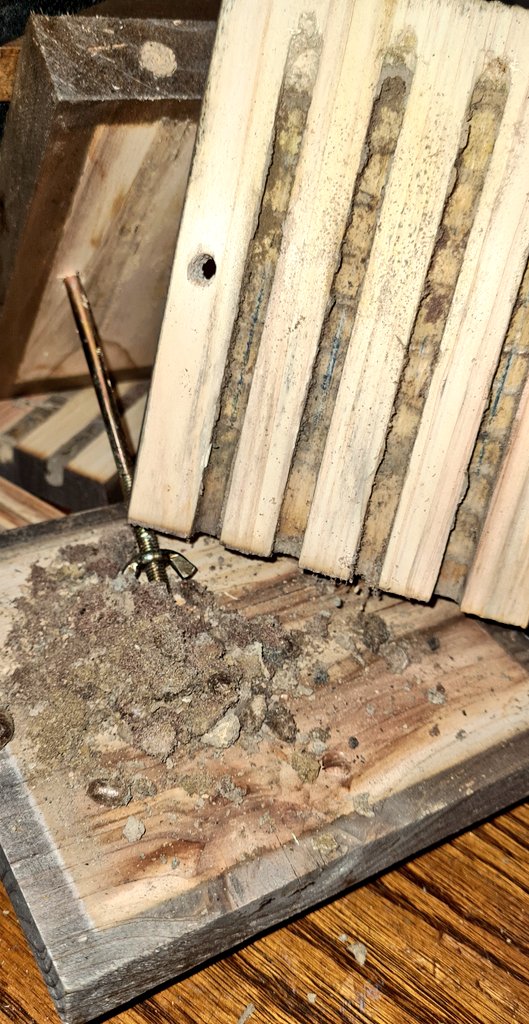
5/18
Repeat the process for each section, and carefully separate the cocoons from the loose soil.
Keep the soil in one place, and try not to spill any.
They will be coated with soil, larva poo, and pollen.
You may want to wear thin rubber gloves 🐝



Repeat the process for each section, and carefully separate the cocoons from the loose soil.
Keep the soil in one place, and try not to spill any.
They will be coated with soil, larva poo, and pollen.
You may want to wear thin rubber gloves 🐝

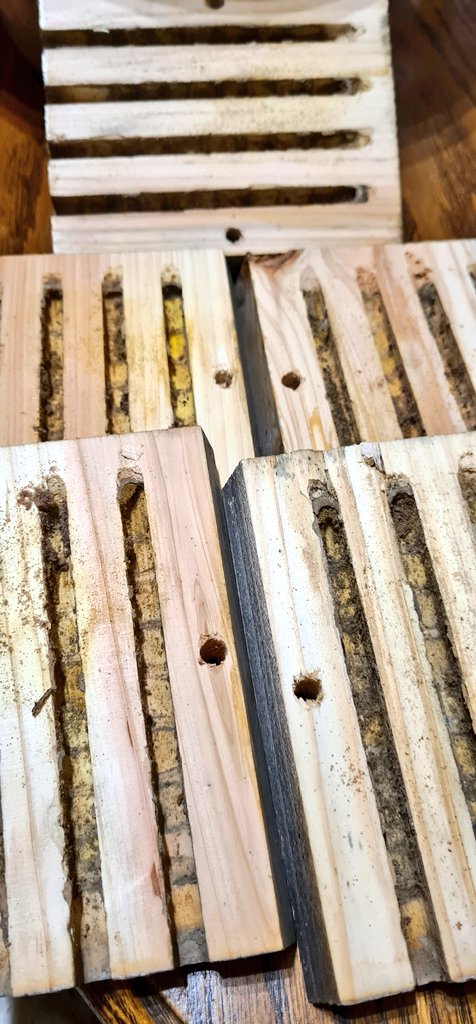

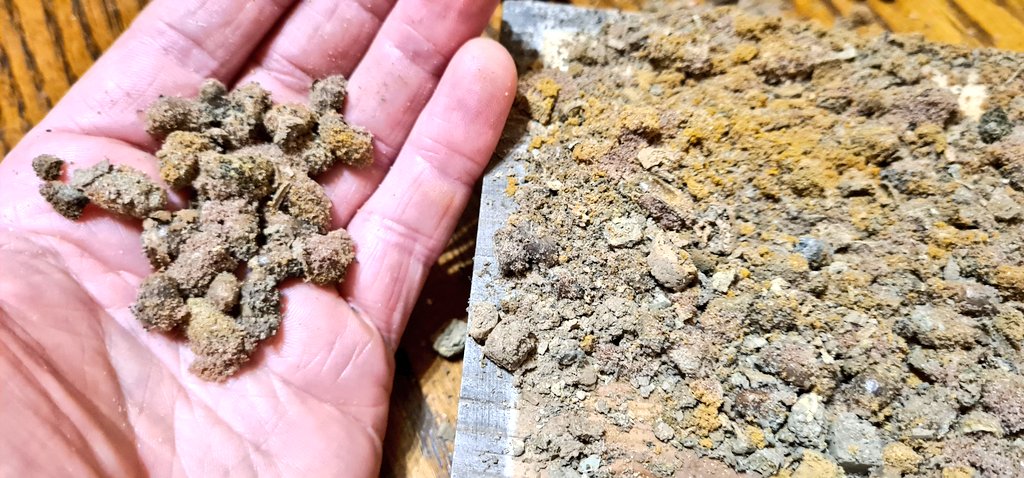
6/18
Place the cocoons in tepid water, around room temperature and no hotter than a babies bath, to wash the soil and pollen grains from them. Dry soil and cocoons will float, and any stones will sink.
You can use your hands, or a very soft brush, but do not squash them 🐝



Place the cocoons in tepid water, around room temperature and no hotter than a babies bath, to wash the soil and pollen grains from them. Dry soil and cocoons will float, and any stones will sink.
You can use your hands, or a very soft brush, but do not squash them 🐝
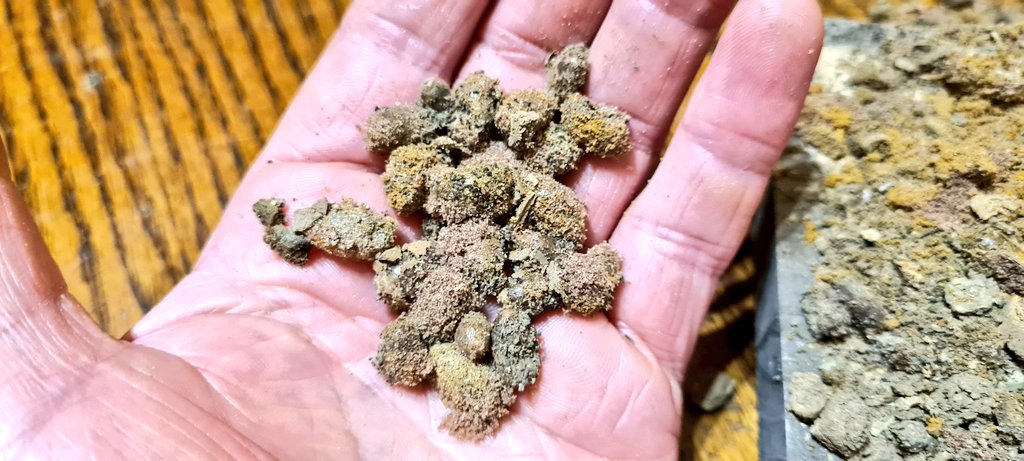



7/18
It's a good idea to run the water through a sieve to avoid losing cocoons down the plug hole, and to stop any stones from going down the drain.
Avoid temperature changes in the water.
Keep rinsing the cocoons until the water becomes clearer 🐝



It's a good idea to run the water through a sieve to avoid losing cocoons down the plug hole, and to stop any stones from going down the drain.
Avoid temperature changes in the water.
Keep rinsing the cocoons until the water becomes clearer 🐝

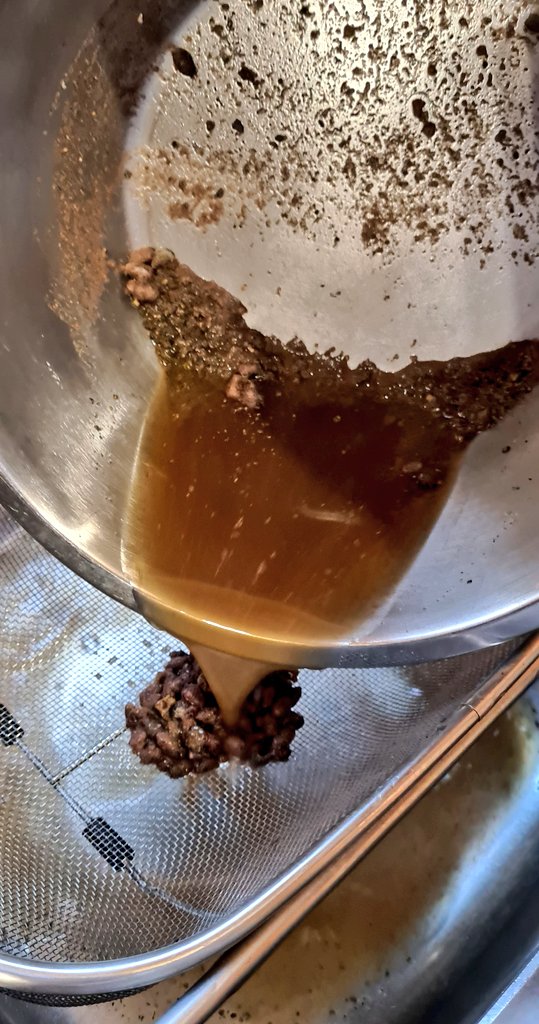


8/18
Keep rinsing and gently washing the cocoons. Don't let them soak for too long, but you can use a brush to help with cleaning.
Don't be afraid to handle them, but remember the cocoons soften when wet, so don't squeeze them 🐝



Keep rinsing and gently washing the cocoons. Don't let them soak for too long, but you can use a brush to help with cleaning.
Don't be afraid to handle them, but remember the cocoons soften when wet, so don't squeeze them 🐝




9/18
If you do not have a sieve, you can allow the water to slowly spill over the top of a container, and hold the cocoons back with your hand, while you pour the dirty water out.
Once the cocoons are clean, it is time to wash the wood sections 🐝



If you do not have a sieve, you can allow the water to slowly spill over the top of a container, and hold the cocoons back with your hand, while you pour the dirty water out.
Once the cocoons are clean, it is time to wash the wood sections 🐝



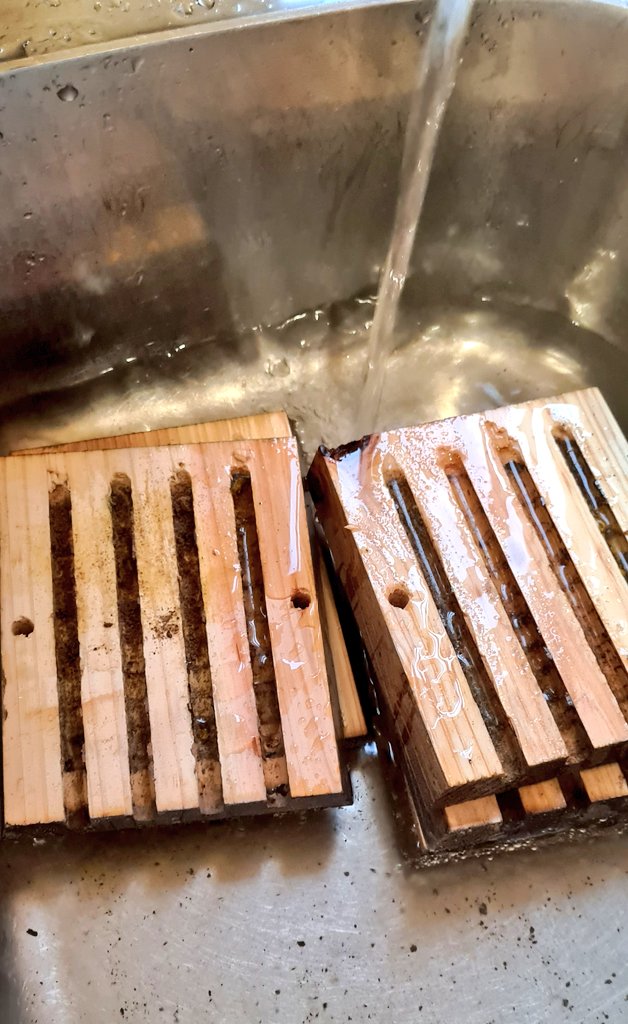
10/18
Wash the wooden sections and use a small brush to clean the grooves, sides and edges.
Don't allow the wood to soak for too long, as the sections will possibly be made up of glued pieces of wood. They may also warp, if left to soak 🐝



Wash the wooden sections and use a small brush to clean the grooves, sides and edges.
Don't allow the wood to soak for too long, as the sections will possibly be made up of glued pieces of wood. They may also warp, if left to soak 🐝

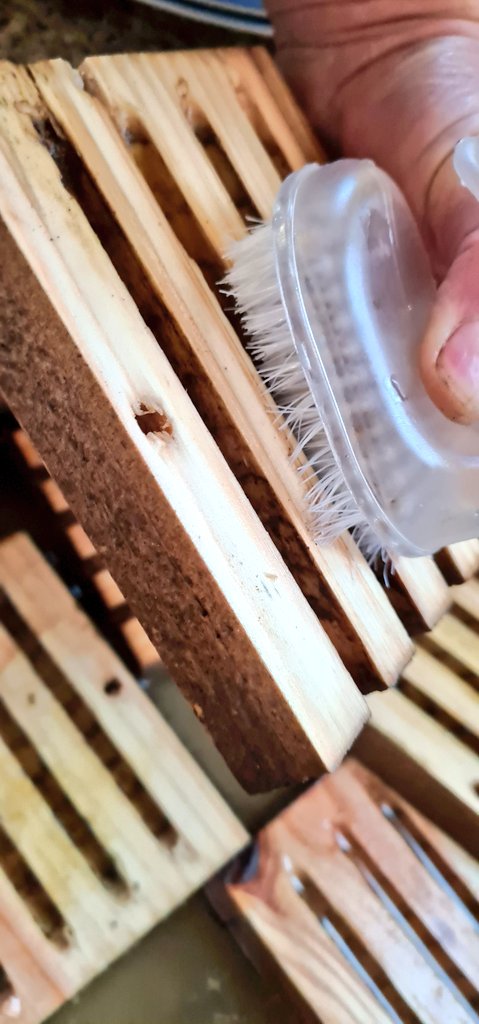


11/18
After the final rinse, the cocoons will still have pollen grains and mud on the outside. You can brush this off, while it is still damp.
Lay the cocoons out to dry, and inspect each one for holes or splits. Dents are ok, as the bee pupa will push those out 🐝



After the final rinse, the cocoons will still have pollen grains and mud on the outside. You can brush this off, while it is still damp.
Lay the cocoons out to dry, and inspect each one for holes or splits. Dents are ok, as the bee pupa will push those out 🐝



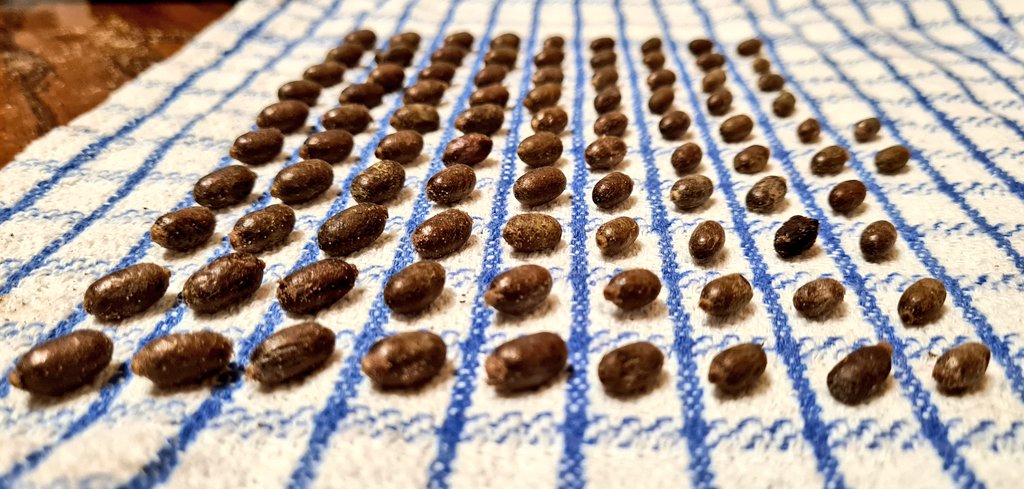
12/18
We collected 92 cocoons from this bee hotel.
That is 92 bee pupae with a better chance of surviving the winter, than being left outside in the cold and wet.
The largest cocoons are females, and the smaller cocoons are males.
Keep some of the soil... you'll see why! 🐝



We collected 92 cocoons from this bee hotel.
That is 92 bee pupae with a better chance of surviving the winter, than being left outside in the cold and wet.
The largest cocoons are females, and the smaller cocoons are males.
Keep some of the soil... you'll see why! 🐝




13/18
The female solitary bee lays female eggs at the back of the groove, and lays male eggs towards the front entrance.
Males are sacrificed to any pests and predators.
When the males emerge, they wait around for the females to mate with, and then die shortly after 🐝



The female solitary bee lays female eggs at the back of the groove, and lays male eggs towards the front entrance.
Males are sacrificed to any pests and predators.
When the males emerge, they wait around for the females to mate with, and then die shortly after 🐝

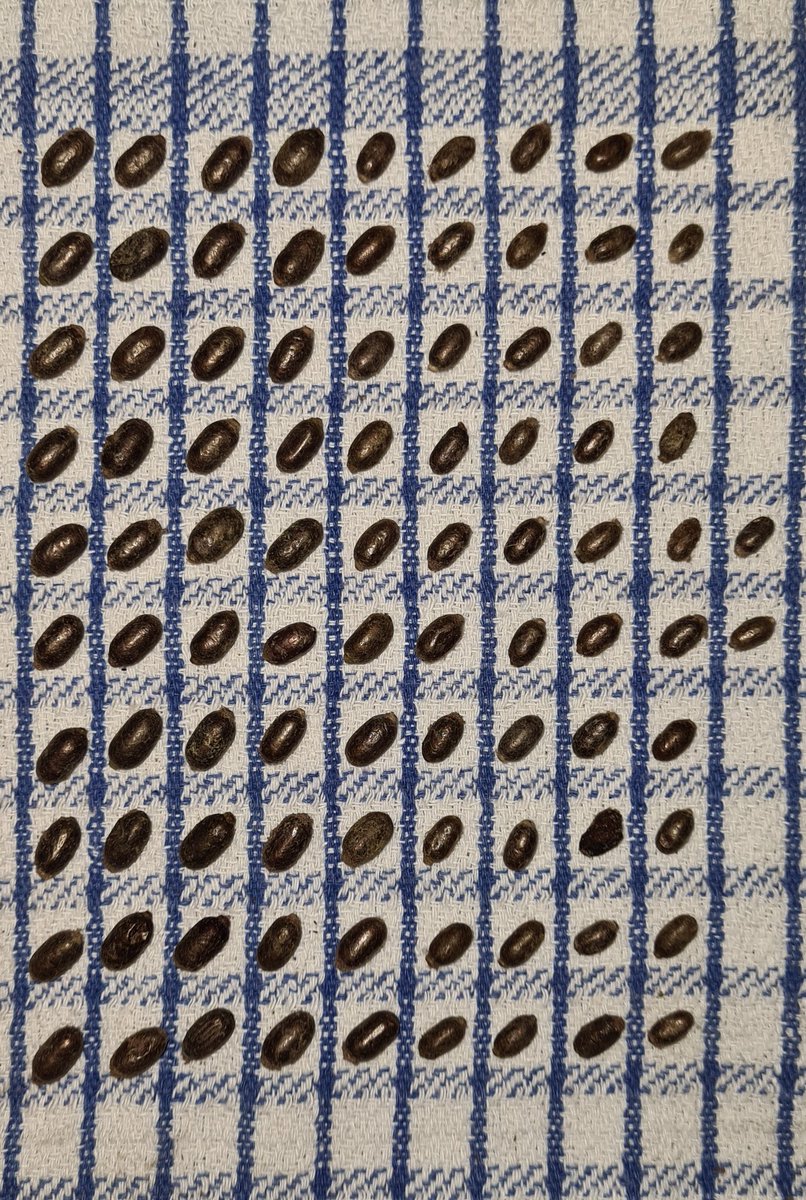


14/18
We examined the soil and cocoons under a microscope.
We found pollen mites in the soil and were feeding on the outside of the cocoons.
The female bee lays an egg in pollen, and when it hatches, the larva spins a cocoon in the space.
Mites feed on pollen in the soil 🐝



We examined the soil and cocoons under a microscope.
We found pollen mites in the soil and were feeding on the outside of the cocoons.
The female bee lays an egg in pollen, and when it hatches, the larva spins a cocoon in the space.
Mites feed on pollen in the soil 🐝




15/18
Don't forget to assemble the bee hotel when it's dry, to keep it safe and to prevent the wood sections from warping.
Store it in a warm dry place, with air movement, to keep it clean and dry indoors.
In the spring, position it back outside, where it was before 🐝



Don't forget to assemble the bee hotel when it's dry, to keep it safe and to prevent the wood sections from warping.
Store it in a warm dry place, with air movement, to keep it clean and dry indoors.
In the spring, position it back outside, where it was before 🐝




16/18
Keep your cocoons in a cool dark place, where the temperature has very little change.
Keep them safe and check on them now and again, during the winter.
Place them outside near your clean bee hotel, in a wooden box with an exit hole.
They will find the hotel nearby 🐝



Keep your cocoons in a cool dark place, where the temperature has very little change.
Keep them safe and check on them now and again, during the winter.
Place them outside near your clean bee hotel, in a wooden box with an exit hole.
They will find the hotel nearby 🐝


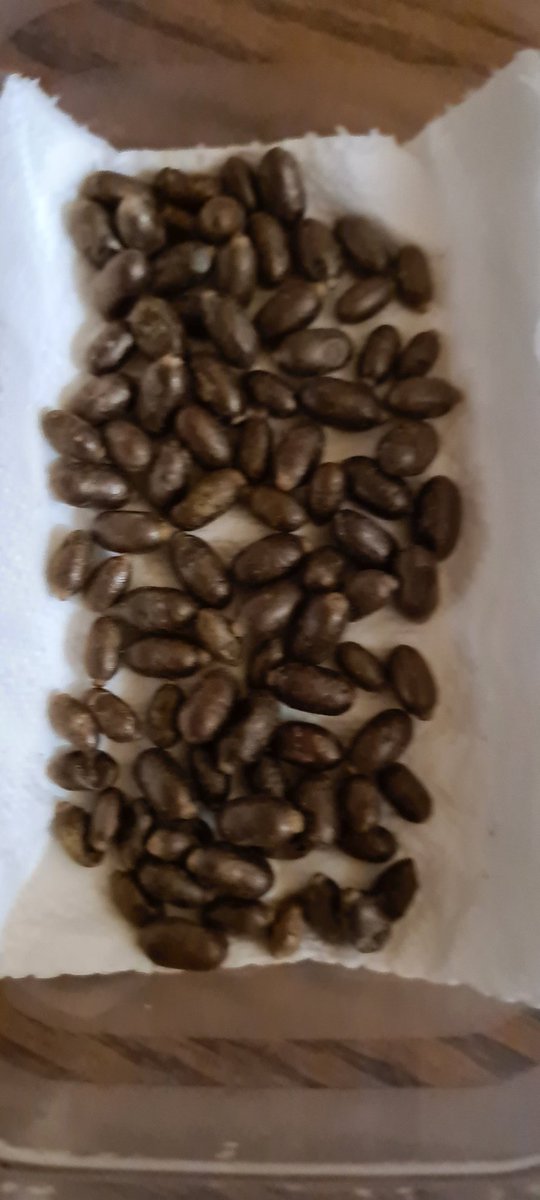

17/18
The reason for keeping the soil?
Wrap it in cling film, and examine it under a microscope.
Here you will see pollen mites, between the soil grains.
Mites crawl from flowers onto the bee and are carried back to the nest, where they mate and multiply feeding on pollen 🐝
The reason for keeping the soil?
Wrap it in cling film, and examine it under a microscope.
Here you will see pollen mites, between the soil grains.
Mites crawl from flowers onto the bee and are carried back to the nest, where they mate and multiply feeding on pollen 🐝
18/18
Thank you, if you've made it this far.
This ends the thread.
We hope it has been educational and will help you to look after your own #BeeHotel so that #SolitaryBees in your area have a better chance of survival.
Please retweet the 1st post and share with your followers🐝



Thank you, if you've made it this far.
This ends the thread.
We hope it has been educational and will help you to look after your own #BeeHotel so that #SolitaryBees in your area have a better chance of survival.
Please retweet the 1st post and share with your followers🐝
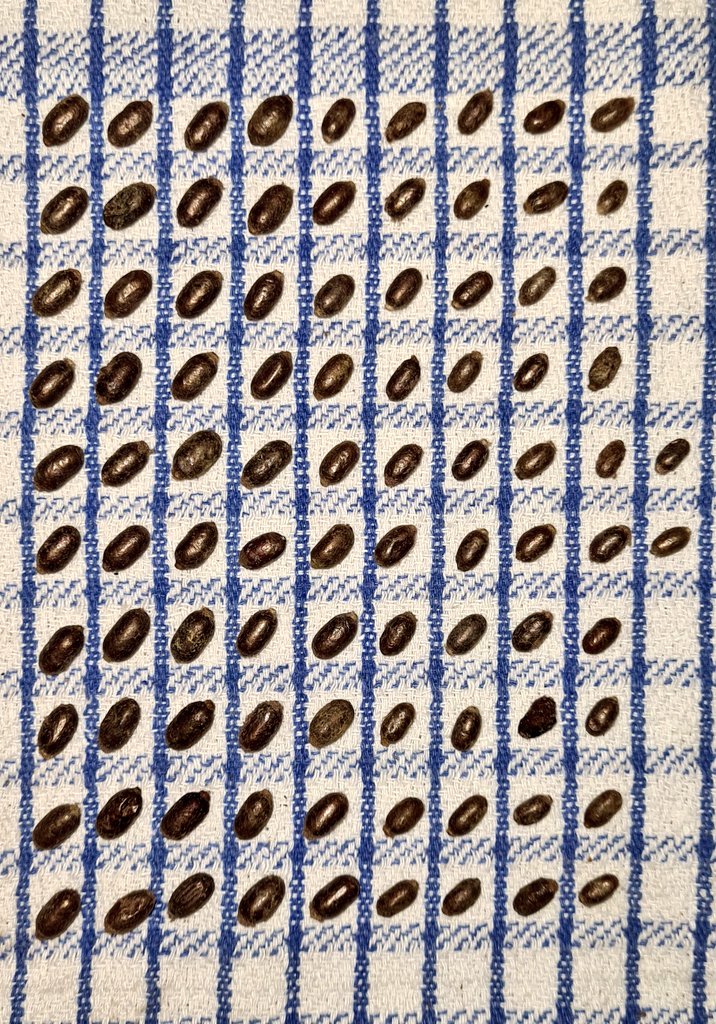



Please view the #Thread from 1/18 🐝
@apimondia @britishbee @BeeCraftMag @bee_improvement @theBeeWatchapp @margaretginman @DrGerryBrierley @B_Strawbridge @SolitaryBeeWeek @beekeepingkids @DefraNature @BeesForDev @BizzleBugs @seed_ball @NTGates @Rachael_Riley13 @Amyelisajem
@apimondia @britishbee @BeeCraftMag @bee_improvement @theBeeWatchapp @margaretginman @DrGerryBrierley @B_Strawbridge @SolitaryBeeWeek @beekeepingkids @DefraNature @BeesForDev @BizzleBugs @seed_ball @NTGates @Rachael_Riley13 @Amyelisajem
• • •
Missing some Tweet in this thread? You can try to
force a refresh



